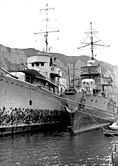Wikipedia:Today's featured article
|
Today's featured article Each day, a summary (roughly 975 characters long) of one of Wikipedia's featured articles (FAs) appears at the top of the Main Page as Today's Featured Article (TFA). The Main Page is viewed about 4.7 million times daily. TFAs are scheduled by the TFA coordinators: Wehwalt, Dank, Gog the Mild and SchroCat. WP:TFAA displays the current month, with easy navigation to other months. If you notice an error in an upcoming TFA summary, please feel free to fix it yourself; if the mistake is in today's or tomorrow's summary, please leave a message at WP:ERRORS so an administrator can fix it. Articles can be nominated for TFA at the TFA requests page, and articles with a date connection within the next year can be suggested at the TFA pending page. Feel free to bring questions and comments to the TFA talk page, and you can ping all the TFA coordinators by adding " |
Featured article candidates (FAC) Today's featured article (TFA):
Featured article tools: |
From today's featured article
Marina Bay MRT station is a Mass Rapid Transit (MRT) interchange station on the North–South (NSL), Circle (CCL) and Thomson–East Coast (TEL) lines in Singapore. Located in the Downtown Core district near Marina Bay, it serves the Marina One Residences, Marina Bay Suites and the Marina Bay Financial Centre. It was one of the last stations to be completed in the early phases of the MRT network, opening on 4 November 1989. The station was the terminus of the NSL until the line's extension in 2014. It became an interchange station with the CCL when the two-station branch extension from Promenade station was completed in January 2012. The TEL station platforms were completed in November 2022, becoming a triple-line interchange on the MRT network. The station features art as part of the MRT network's Art-in-Transit programme. The sculpture Flowers in Blossom II is over the CCL mezzanine. The CCL platforms feature photographs by Nah Yong En and the TEL station features murals by Tang Ling Nah. (Full article...)
From tomorrow's featured article
Thomas Percy was a member of the failed Gunpowder Plot. Following King James's accession to the English throne in 1603, Percy became disenchanted with the new king, who he supposed had reneged on his promises of toleration for English Catholics. He joined Robert Catesby's conspiracy to kill the King and his ministers by blowing up the House of Lords with gunpowder. Percy helped fund the group and secured the leases to properties in London, including the undercroft beneath the House of Lords where the gunpowder was placed. When the plot was exposed on 5 November 1605, Percy fled to the Midlands, catching up with other conspirators travelling to Dunchurch. At the border of Staffordshire, they were besieged by the Sheriff of Worcester and his men. Percy was reportedly killed by the same musket ball as Catesby and was buried nearby. His body was later exhumed, and his head exhibited outside Parliament. (This article is part of a featured topic: Gunpowder Plot.)
From the day after tomorrow's featured article
Ljubljana was the third and last Beograd-class destroyer built for the Royal Yugoslav Navy in the late 1930s. She was designed to operate as part of a division led by Dubrovnik, the flotilla leader. Ljubljana entered service in November 1939, was armed with a main battery of four Škoda 120 mm (4.7 in) guns in single mounts, and had a top speed of 35 knots (65 km/h; 40 mph). In 1940, Ljubljana ran aground on a reef off the Yugoslav port of Šibenik, where, badly damaged, she was taken for repairs. Yugoslavia entered World War II when the Axis powers led by Germany invaded in April 1941, and Ljubljana—still under repair—was captured by the Royal Italian Navy. After repairs were completed, she saw active service in the Royal Italian Navy under the name Lubiana, mainly as a convoy escort on routes between Italy and North Africa. She was lost on 1 April 1943, when she ran aground and was abandoned off the Tunisian coast. (This article is part of a featured topic: Ships of the Royal Yugoslav Navy.)




